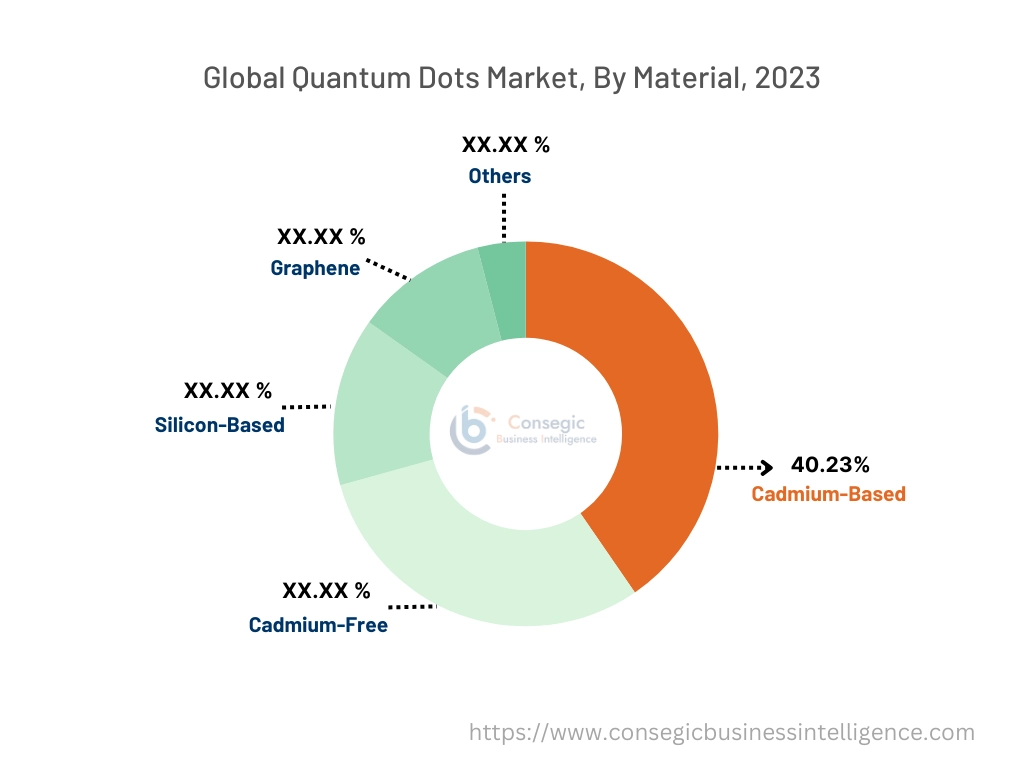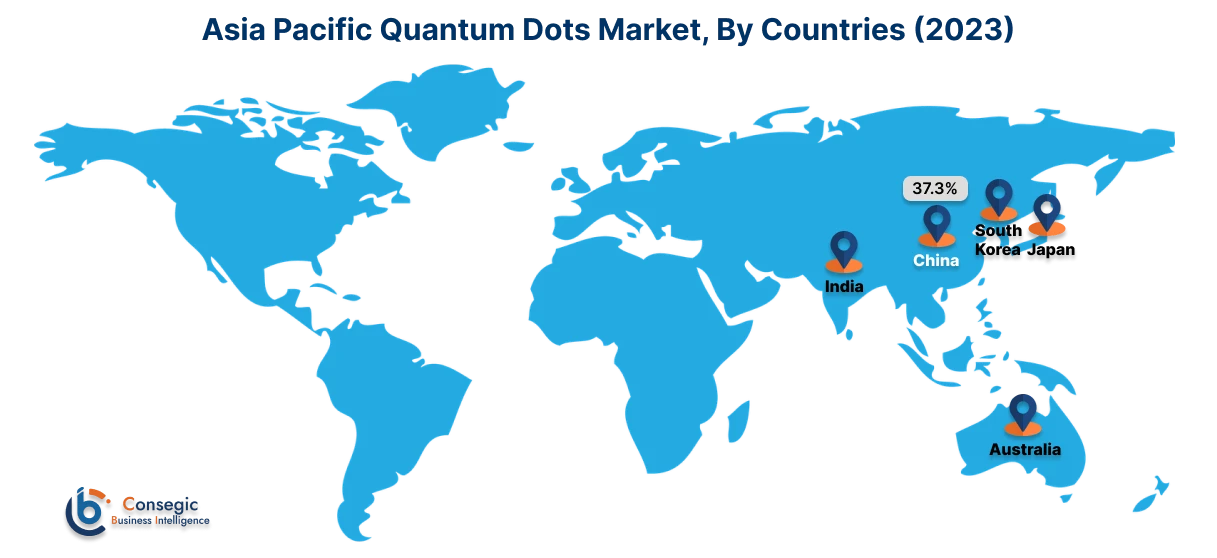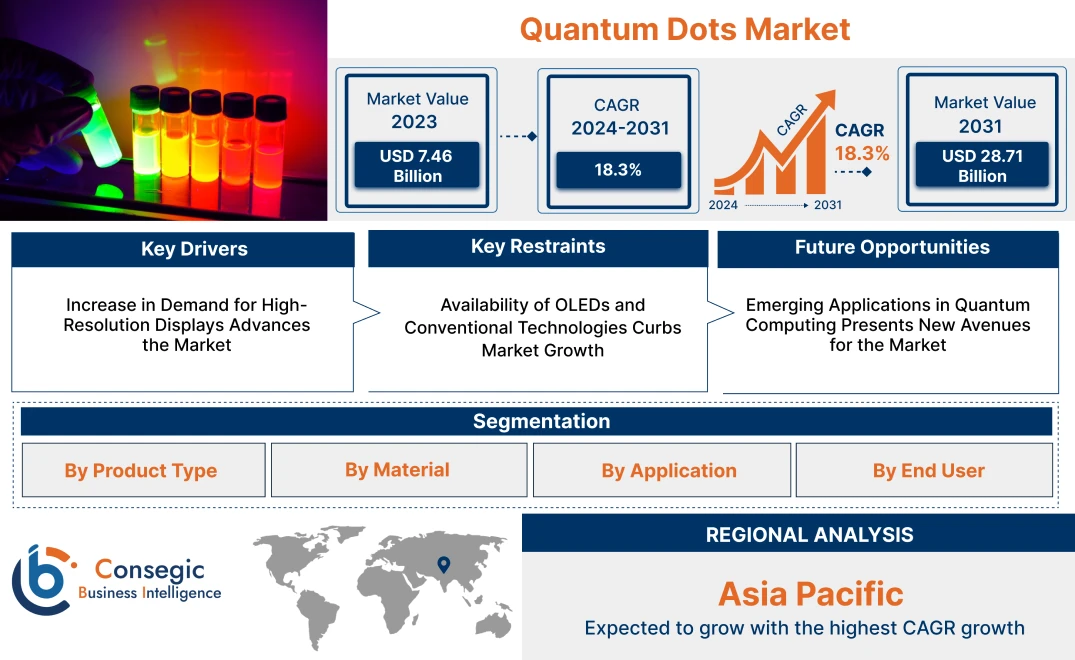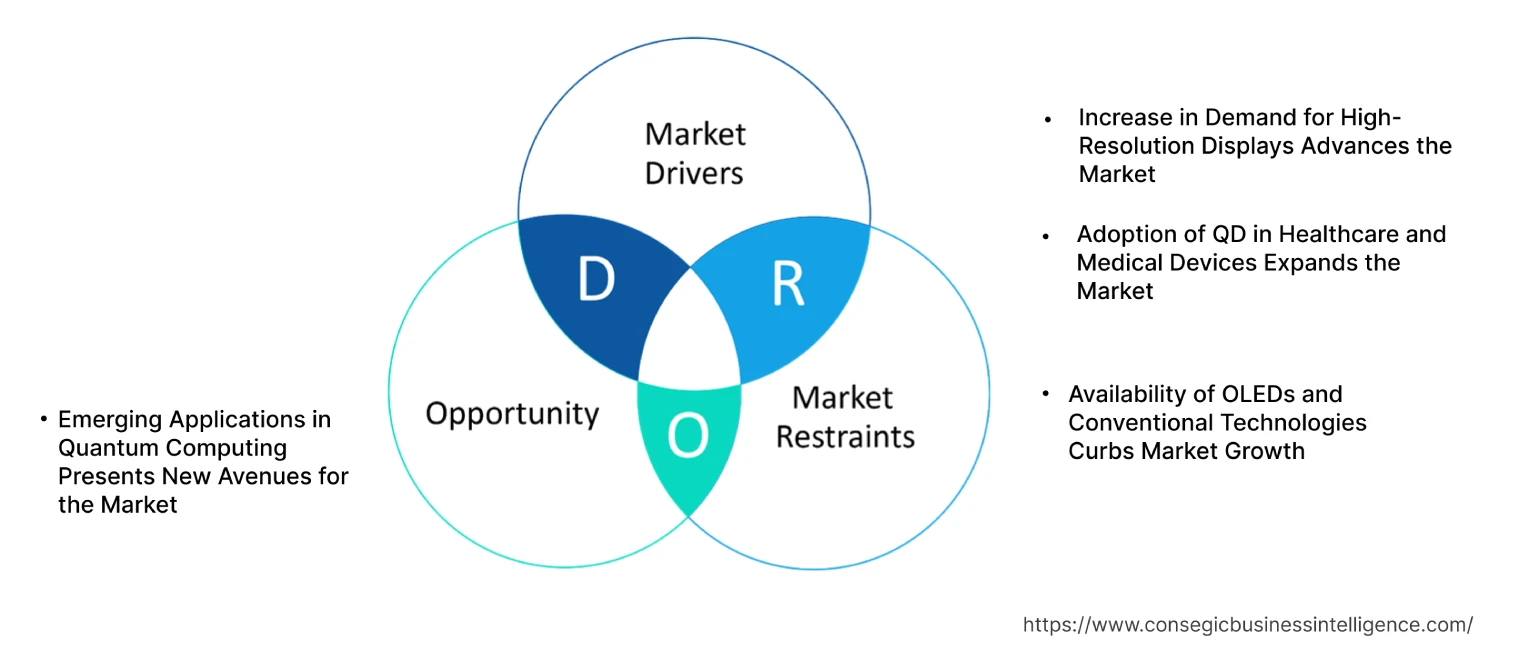- Summary
- Table Of Content
- Methodology
Quantum Dots Market Size:
Quantum Dots Market size is estimated to reach over USD 28.71 Billion by 2031 from a value of USD 7.46 Billion in 2023 and is projected to grow by USD 8.70 Billion in 2024, growing at a CAGR of 18.3% from 2024 to 2031.
Quantum Dots Market Scope & Overview:
Quantum Dots (QDs) are nano-scale semiconducting particles that retain rare electronic and optical properties. The QDs range from 2 to 10 nanometers which renders them small enough to model quantum mechanical phenomena. QDs have a distinct energy level that makes them capable of emitting light at specified wavelengths with proper stimulation. However, the color of the light emission relies on the dimensions of the QDs For example, larger QDs emit red light, while smaller QDs often emit blue light. Their unique properties of narrow emission spectrum and high brightness make them an ideal choice for activities that require precise light reproduction, rendering them efficient light emitters. They also have high stability and can effectively convert energy into light. QDs have varied benefits, such as they are easy to customize and energy efficient making them suitable for a wide range of applications. Their usage can be found in sensors, the healthcare sector, display technology, and quantum computing .
Quantum Dots Market Insights:
Key Drivers:
Increase in Demand for High-Resolution Displays Advances the Market
Quantum dots (QDs) give pure and saturated colors. This enhances the display quality raising the demand for integration in 4K/8K ultra-high-definition (UHD) screens. The superior contrast level of QLEDs greater clarity and precision in details. They are also energy efficient as they provide high-quality brightness without extra energy consumption.
- In April 2024, Samsung launched its brand-new product, the Samsung QN85D Neo QLED 4K Smart TV. This product has quantum matrix technology along with 4K AI upscaling. It provides the consumer with a visual with unprecedented sharp clarity and has a motion detection algorithm to give a more immersive experience.
Therefore, the draw of UHD displays has raised the need for high-resolution displays for not only viewing but also for gaming and streaming. This has led to the diversification of the quantum dots market growth.
Adoption of QD in Healthcare and Medical Devices Expands the Market
QDs can emit specific wavelengths of light and have high fluorescence stability at the nanoscale. This is effective for bioimaging processes, such as molecular imaging or cellular imaging. They can also detect cancer as they can be designed to find tumor cells at the nascent stages and offer theranostics. QD-based biosensors can look after glucose levels. They can be combined into in-vitro diagnostic (IVD) tools and point-of-care (POC) devices. It makes the detection of genetic diseases easy and makes medical care portable to remote areas.
- A team of Chinese researchers developed the use of metal-free graphene QDs for a non-invasive cancer treatment in February 2024. This new development is cost-effective while addressing the challenges faced by metal-based nanozyme treatment.
Therefore, as QD tech is adopted into healthcare systems, the provisions of development regenerative medicines increase. This effectively leads to quantum dots market growth.
Key Restraints :
Availability of OLEDs and Conventional Technologies Curbs Market Growth
Alternatives like organic light-emitting diodes (OLEDs) and conventional LCDs or LEDs for lights, displays, and solar cells often provide the QD market with competition. These technologies are more cost-effective than QD tech for its ease of production. They are also easily scalable, unlike QDs which makes them easier for mass-production. OLEDs are mature technologies with a wide base and connection. These alternative techs have suppliers and end-users that get industry preference, creating a robust ecosystem. This makes the shift to QD tech more complex.
- For instance, the Samsung S90D QD-OLED TV provides its users with cloud gaming as well as a state-of-the-art Dolby Vision HDR. It offers an immersive experience with its Real Depth Enhancer and has no virtual lag or blur.
Thus, well-integrated technologies create boundaries for QD tech adoption, which leads to restraining the quantum dots market demand.
Future Opportunities :
Emerging Applications in Quantum Computing Presents New Avenues for the Market
Quantum Computing employs quantum mechanical phenomena like superposition and entanglement to work on data analysis. When QDs are integrated into quantum computing systems it has the capability to generate, measure, and manipulate quantum bits (qubits). This helps in maintaining the stability and coherence of qubits for an extended period of time. It makes QD-based quantum computing systems more attractive to consumers.
- In October 2023, a new study led by a research team from Korea, Japan, and the USA presented an innovative quantum platform that employs an atom's single-cell electron spin to develop a multi-qubit system.
Thus, as per the analysis, quantum computing stands to provide the quantum dots market opportunities, as QDs are easy to manufacture and they scale up the building of quantum computers.
Quantum Dots Market Segmental Analysis :
By Product Type:
The market is segmented based on product type into QD Displays, QD Solar Cells, QD Sensors, QD Lighting (LEDs), QD Lasers, and others.
Trends in the Product Type:
- They have pixel-level algorithm optimization for the reduction of power consumption.
- The consumer trend of changing angles to view QD TVs, monitors, etc is facilitated by QDs as they minimize picture quality degradation.
Quantum Dots displays accounted for the largest revenue of the overall quantum dots market share in 2023.
- QD displays are brighter and have more vibrancy in color and contrast compared to conventional LCDs.
- High requirements for 4k/8K ultra-high definition(UHD) in TVs and monitors result in the implementation of QD tech to achieve high-quality displays.
- QDs are energy efficient as they have precision over light emission. This reduces energy consumption, making it an energy-efficient option.
- For instance, in 2024, South Korean scientists lead research for the development of stretchable QLED displays. These researchers from the Institute for Basic Science used a third material semiconducting polymer, TFB to successfully improve both the stretchability of the device and the efficiency of hole injection.
- Thus, as progressive research and development is done in the QD tech field, such as cadmium-free quantum dots, the QD display sector will hold its position as the largest revenue-generating segment.
Quantum Dots solar cells are expected to have the fastest-growing CAGR during the forecasted period.
- QD solar cells can surpass the efficiency of conventional silicon-based solar cells as they can be tuned to absorb a wide range of solar spectrum.
- This type of product is cost-effective as it is easier to produce with a solution-based production process like roll-to-roll manufacturing, printing, etc.
- QD-based solar cells are thin films, making them light and flexible for integrating into portable electronics, wearable devices, etc.
- These are durable as they are less likely to degrade from UV exposure, increasing their longevity and making them ideal for sustainable development.
- For instance, in February 2024, a group of researchers from the School of Energy and Chemical Engineering announced the development of state-of-the-art solar cells with an effective ligand exchange process. This method allows for the manufacture of perovskite QDs (PQDs) based on organic cations. It results in excellent stability and elimination of internal flaws in the photoactive layer.
- Therefore, as per quantum dots market analysis, QD solar cells offer eco-friendly advancements along with efficiency to the consumer market which would result in faster growth in this market in the future.
By Material:
The market is segmented based on material into Cadmium-Based, Cadmium-Free, Silicon-Based, Graphene, and others.
Trends in the Material:
- QD materials provide exceptional electronic conductivity which recently led to their utilization in multiplexed imaging.
- The trend of manufacturing dyes and drugs by utilizing QD materials as they have colloidal stability in flowing environments is on the rise.
Cadmium-based accounted for the largest revenue share of 40.23% of the total quantum dots market share in 2023.
- Cadmium-based quantum dots have excellent optical properties, like better efficiency in light emission, making them ideal for lighting and display techs.
- Certain cadmium-based QDs, like Cadmium Selenide, are used in the electronics industry for the manufacturing of high-end monitors, smartphone screens, etc.
- They can also be utilized for solar cells or sensors as they have size-tunable properties and exceptional characteristics like stability and versatility.
- For instance, Cadmium Selenide Zinc Sulfide QD 540nm, a product of Cyto Diagnostics, offers high efficiency and stability for up to one year. It has an emission length of 530 nm to 559 nm.
- Therefore, as per analysis, cadmium-based QDs is a well-established technology that has optimized the quantum dots market demand by being its largest revenue-generating sector.
Cadmium-free segment is expected to have the fastest-growing CAGR during the forecasted period.
- Cadmium use is often restricted by certain governments, like in Europe. This has led to the growth of cadmium-free quantum dots.
- Cadmium-free QDs such as Indium Phosphide, are environment friendly, making them an ideal choice for manufacturers who are adopting green technologies.
- They are used in electronics, medical imaging, etc as they provide brightness, energy efficiency, and color accuracy, without affecting the environment.
- For instance, in July 2021, the National Library of Medicine (NLH) published an online study on cadmium-free type II Zinc Oxide, Zinc Sulphide, and Indium Phosphide, QDs. The study addresses the discrepancies such as the low quantum yield of type II nanocrystal QDs and highlights how these QDs can achieve superior quantum yield.
- Thus, as consumers grow more aware of the environmental effects of cadmium, they tend to shift to cadmium-free QDs. This would lead this sector to have growth in the future.

By Application:
The market is segmented based on its application into displays, medical devices, solar cells, LED lighting, photodetectors & sensors, and others.
Trends in the Application:
- Displays with QDs can now cover 90% of the color gamut, unlike LCDs.
- The quantum dots market trend of introducing QD-OLED hybrids, which combine the provisions of color emitters of OLED and QD's color conversion, has expanded the market.
Displays accounted for the largest revenue share in 2023.
- QDs enhance the color gamut of displays as they emit colors like red, blue, etc making them suitable for the production of vivid and lifelike images.
- They are energy-efficient and meet the needs of the consumer market for energy-saving systems and devices.
- The quantum dot technology led to the manufacture of 4K/8K UHD displays, which have great vibrancy and contrast.
- For instance, in May 2023, Samsung announced in a press release that they have crossed the mark of 1 million shipments for new hybrids of QD-OLED display panels for TVs and monitors.
- Thus, as the consumer market shifts from conventional display systems, the QD market experiences expansion in the display sector.
Solar Cells are expected to have the fastest-growing CAGR during the forecasted period.
- QDs is a third-generation solar cell technology, that challenges the limits of silicon-based solar cells.
- QDs can generate multiple excitons from one photon which increases the efficacy of light conversion. This remodels the potential of solar power generation for better, by resulting in higher energy output from limited amounts of sunlight.
- They have the potential to be integrated with existing techs, creating a hybrid setup that boosts the range of light absorption.
- In February 2024, researchers from the Ulsan National Institute of Science & Technology (UNIST) developed innovative and efficient solar cells with QDs. They used perovskite QDs (PQDs) to scale up the production of energy-efficient solar cells.
- Therefore, as per the analysis, the ongoing governmental research and development for renewable energy sources would lead to rising quantum dots market trends.
By End-User:
The market is segmented based on end-users into Consumer Electronics, Healthcare, Energy, Optoelectronics, and others.
Trends in the End-User:
- In healthcare, the recent trend of QD tech, such as smart monitoring, telemedicine, etc effectively provides cellular tracking.
- They also are allowing the development of single-electron transistors for the consumer electronics industry.
Consumer electronics accounted for the largest revenue share in 2023.
- High demands for vibrant displays in the consumer market and quantum dot (QD) technology help in achieving superior picture quality. This results in the integration of QD tech for the production of devices like OLED TVs, monitors, etc.
- QD tech is also compatible with smartphones, wearable devices, entertainment systems, etc due to its capability of being energy efficient.
- QD tech goes beyond displays and can enhance sensors, and cameras, and can be utilized in QD computing.
- For instance, in 2024, TCL announced the launch of a new premium QD-mini LED TV in Dubai. They unveiled the cutting-edge TCL C855 Premium QD-Mini LED TV 4K TV. This new product offers an immersive and life-like experience to the consumers.
- Therefore, as per analysis, major consumer electronics companies like Samsung, LG, etc are adopting QD technology in their displays and other products. This strengthened this sector's position as the largest revenue-generating segment in the QD market.
Healthcare is expected to have the fastest-growing CAGR in the quantum dots market during the forecasted period.
- QDs are employed in medical imaging processes such as bioimaging, fluorescence imaging, etc due to their excellent brightness and stability.
- They can also be used to target particular tissues, cells, etc which improves drug delivery accuracy.
- QD can detect biomarkers connected to various diseases as they have multi-color fluorescent signals. This makes them suitable for providing medical workers with more accurate pictures while detecting and diagnosing diseases.
- For instance, in January 2024, QDI Systems raised funding of €5 million to increase the scalability of QD tech in the medical field for better X-ray imaging.
- Thus, as QD tech provides provisions of effective treatments with minimal side effects, they are set to have the fastest growth in the future.
Regional Analysis:
The regions covered are North America, Europe, Asia Pacific, the Middle East and Africa, and Latin America.

Asia Pacific region was valued at USD 2.25 Billion in 2023. Moreover, it is projected to grow by USD 2.63 Billion in 2024 and reach over USD 9.11 Billion by 2031. Out of this, China accounted for the maximum revenue share of 37.3%.
The Asia Pacific (APAC) region has a large consumer base and manufacturing unit for the electronics sector. They have a high demand for 4K/8K ultra HD display screens. Nations like China, South Korea, Japan, etc, are propelling the use of QD technology for displays of OLED monitors and TVs. This integration has resulted in better color accuracy and brightness, making it attractive to potential buyers.
- In November 2022, Samsung (South Korea) announced the launching of two new products in their QD (OLED) series. The Samsung (QD)OLED S95B and Odyssey (QD)OLED G8 have phenomenal color performance and a rich image quality. These products are curved gaming monitors which also boast excellent sound systems for an immersive experience.
Thus, the global quantum dots market benefits greatly from the advancements made in the APAC region.

North America is estimated to reach over USD 10.28 Billion by 2031 from a value of USD 2.62 Billion in 2023 and is projected to grow by USD 3.06 Billion in 2024.
North America, especially in the United States, houses an overwhelming number of tech companies, universities, and research institutes. These places contribute a lot to the research and development (R&D) of nanotechnology, including QD technology, which fosters a robust environment for the quantum dots market expansion. The government also supports these R&D efforts through state-initiated funding, through agencies like the National Science Foundation (NSF). The quantum dots market opportunity rises with every new development done in the nanotech field.
- In 2023, the National Science Foundation (NSF) released a press report about the Nobel Prize winners in Chemistry. They had discovered QDs and their high-quality dependable production process. NSF provided support for two of the laureates of the 2023 Nobel Prize in Chemistry in their research and early stages of careers.
In Europe, green technology, energy efficiency, and sustainability are highly valued. The new and developing quantum dot technology fits the ideals of the European quest for lowering carbon footprints and adopting renewable energy sources.
The regional trends show that the Middle East and Africa (MEA) readily invest in the development of their infrastructure for building smart cities. Nations like the UAE, Saudi Arabia, etc are working towards developing energy-efficient buildings by employing smart technologies like QD technology for advanced lighting, displays, sensors, etc. The utilization of QD-based products in urban housing results in the quantum dots market expansion in this region.
Latin America has a robust market that has high demands for solar power generation, especially in the regions of Chile, Brazil, etc. Quantum dots technology can be employed in photovoltaic cells to improve the efficacy of energy conversion. The strategic advantage that Latin Americans have of abundant natural resources and solar irradiance drives the QD market in this region.
Top Key Players & Market Share Insights:
The quantum dots market is highly competitive with major players providing services and products to the national and international markets. Key players are adopting several strategies in research and development (R&D), product innovation, and end-user launches to hold a strong position in the quantum dots market. Key players in the global quantum dots industry include:
- NNCrystal US Corporation (US)
- Nanoco Group plc (U.K)
- QustomDot BV (Belgium)
- QD Laser (Japan)
- Quantum Materials Corp. (U.S.)
- QDI Systems (Netherlands)
- Thermo Fisher Scientific Inc. (US)
- Ocean Nanotech, LLC.(US)
- Shoei Chemical, Inc. (Japan)
- Samsung Electronics Co Ltd. (South Korea)
- UbiQD, Inc. (U.S.)
Recent Industry Developments :
Product Launches:
- In February 2024, Quantum Science announced the launch of a new product, INFIQ QDs, on their Merck Sigma-Aldrich website. This infrared QD technology company offered up this new product to their customers which has an absorption maxima at a range of 800 nanometers (nm) to 980 nanometers (nm). It is also lead-free and is silver sulfide and silver selenide-based.
- In April 2024, SmallHD announced the launch of a brand new monitor, Quantum 32, for perfect cinematography. This new product has a 31.5' OLED monitor and is specifically designed to give its users HDR/SDR images for post-production color grading. It employs the next-gen Quantum Dot OLED display tech that integrates extraordinary luminance and color uniformity with an excellent wide-view slant.
Mergers and Acquisitions:
- In September 2023, Shoei Chemical, a Japanese company announced its acquisition of Nanosys's quantum dot business. Shoei Chemical Inc. is an advanced material production company that aims to improve research and development conditions. Nanosys Inc. is an innovative company in California, that focuses on developing and providing QD tech to the display sector. This asset transaction is a symbiotic deal that cemented the position of Shoei Chemicals and gave Nanosys the chance to maintain developing exceptional QD tech and delivering them on the global platform.
Partnerships and Collaborations:
- In August 2023, UbiQD decided to broaden its collaboration agreement with First Solar. They aimed to integrate fluorescent QD tech in developing QD-enhanced solar modules. It would expand the benefits of QD tech to bring about environmental changes and make economic advancement more sustainable.
Investments and Funding:
- In January 2024, QDI Systems, a Groningen-based startup, secured funding of €5 million to increase the scalability of their quantum dots technology. This fund drive was organized by the Investment and Development Agency for the Northern Netherlands and aims to provide QD tech for the medical sector. QDI Systems believes that QD tech could reshape the ideals of X-ray imaging, increase the speed of mammography screening, and bring about precise diagnostics at nascent stages.
Quantum Dots Market Report Insights :
| Report Attributes | Report Details |
| Study Timeline | 2018-2031 |
| Market Size in 2031 | USD 28.71 Billion |
| CAGR (2024-2031) | 18.3% |
| By Product Type |
|
| By Material |
|
| By Application |
|
| By End Use Industry |
|
| By Region |
|
| Key Players |
|
| North America | U.S. Canada Mexico |
| Europe | U.K. Germany France Spain Italy Russia Benelux Rest of Europe |
| APAC | China South Korea Japan India Australia ASEAN Rest of Asia-Pacific |
| Middle East and Africa | GCC Turkey South Africa Rest of MEA |
| LATAM | Brazil Argentina Chile Rest of LATAM |
| Report Coverage |
|
Key Questions Answered in the Report
Who are the major players in the quantum dots market? +
The major players in the market include NNCrystal US Corporation (U.S.), Crystal US Corporation (US), QD Laser (Japan), Nanoco Group plc (U.K.), Quantum Materials Corp. (U.S.), QDI Systems (Netherlands), Shoei Chemical, Inc. (Japan), Samsung Electronics Co Ltd. (South Korea), Thermo Fisher Scientific Inc. (U.S.), Ocean Nanotech, LLC. (U.S.), UbiQD, Inc. (U.S.), and QustomDot BV (Belgium).
What specific segmentation details are covered in the quantum dots market report? +
The quantum dots market is segmented into product type, material, application, and end-user industry.
Which is the fastest-growing region in the quantum dots market? +
Asia Pacific is the fastest-growing region in the quantum dots market.


